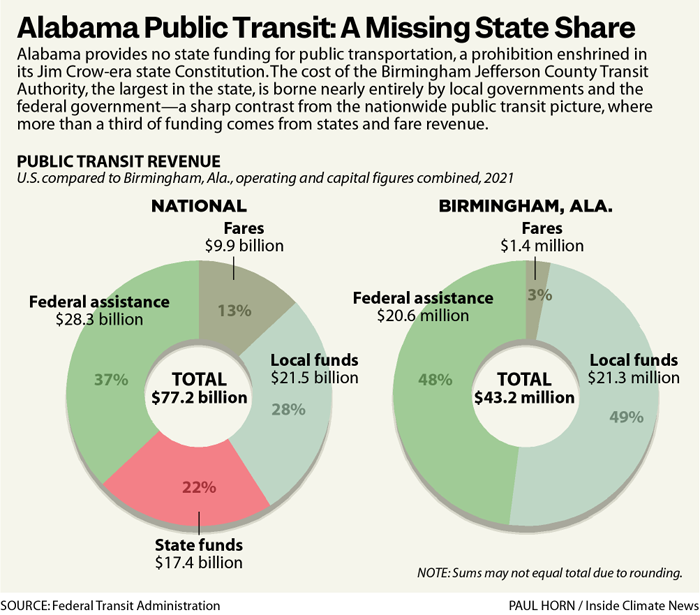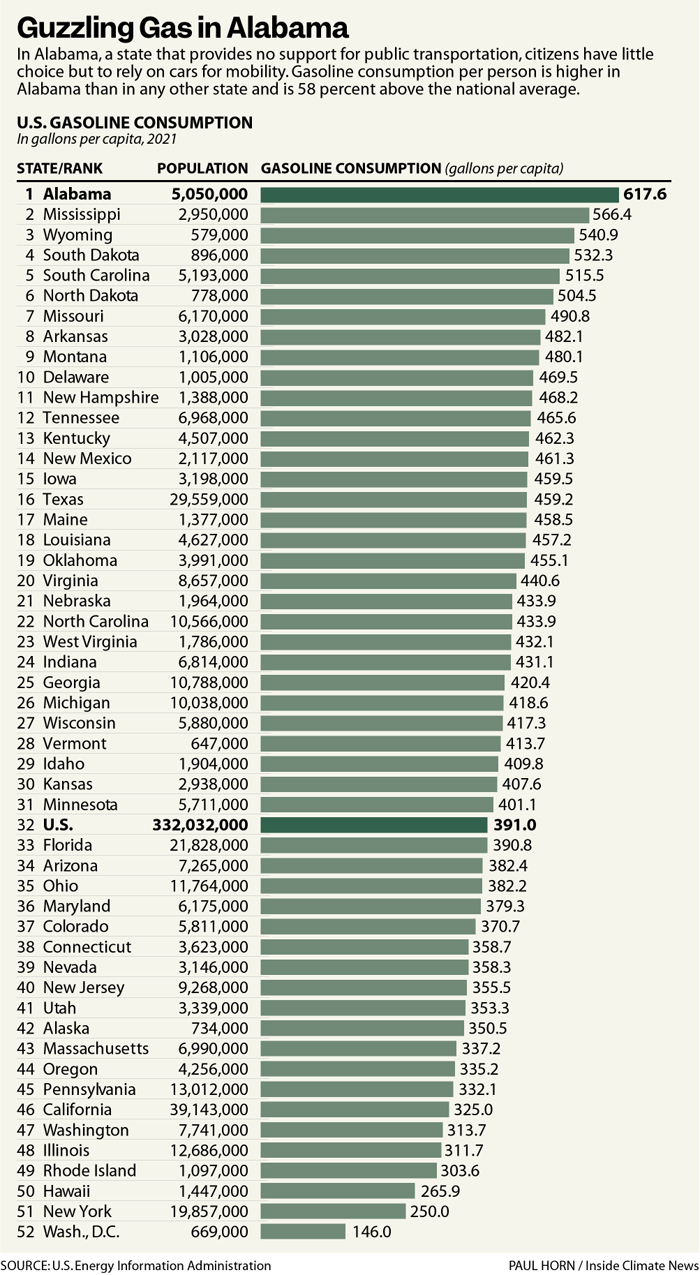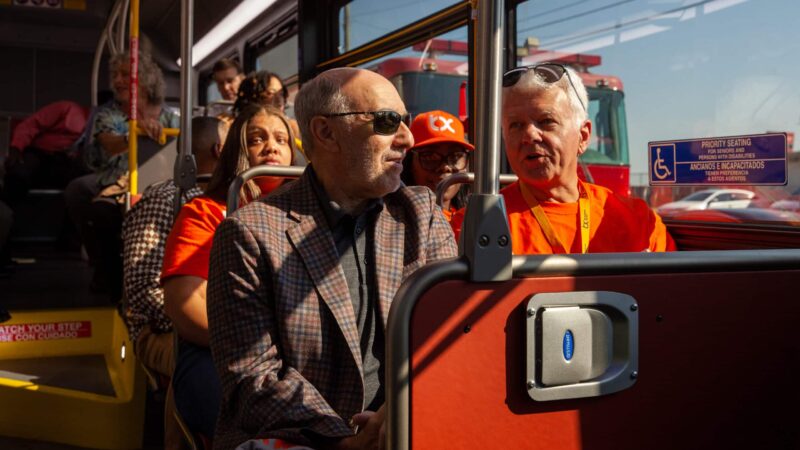Birmingham public transit inches forward with federal help and no state funding
Dozens of people took the chance to ride on Birmingham’s new Xpress Rapid Bus Line on Thursday, Sept. 22, 2022.
This article originally appeared on Inside Climate News, a nonprofit, independent news organization that covers climate, energy and the environment. It is republished with permission. Sign up for their newsletter here.
By Marianne Lavelle, Inside Climate News
BIRMINGHAM, Ala.—When she was a child in Charleston, S.C., Marva Douglas remembers she had to ride in the back of the bus to visit the zoo, museum or library.
But at age 84, she is dismayed to think that in some ways, she had it better in the 1940s than young people growing up today in many neighborhoods of her adopted city of Birmingham. They have little or no bus service at all to the places that could open up their worlds.
“I want them to have as much access to whatever it is that is going to enhance their lives,” said Douglas, explaining the quest she embarked on 27 years ago—an unsuccessful mission, so far—to get Alabama to join the other 49 states in funding public transportation. A former teacher and corporate public relations executive, Douglas has devoted her retirement to education and lobbying on one subject: the benefits that robust public transit would bring to Alabama.
According to the most recent Federal Transit Administration data, Alabama is alone among states in providing essentially no support to public transit. In the state where Rosa Parks, a Montgomery seamstress, catalyzed the civil rights movement nearly 70 years ago by taking a seat near the front of a city bus, a prohibition against state funding for public transportation is embedded in Alabama’s Jim Crow-era Constitution.
As a result, Alabama is automobile-dependent—a burden that falls most heavily on urban populations, which are disproportionately poor and Black. The costs include hampered access to jobs, per-person gasoline costs 40 percent above the national average and urban air pollution at levels found in far more populous cities.
Alabama, in fact, has the highest per-person gasoline consumption in the nation, according to an Inside Climate News analysis of federal energy data. The excess carbon emissions are so great that it would be like shutting down three coal-fired power plants, if Alabama could only rein in its gasoline use so it was on par with the national average.
It’s the kind of climate and environmental justice challenge that President Joe Biden pledged to tackle when he took office. And indeed, public transportation in Alabama has gotten new help from the federal government under Biden’s watch, as is clear in the state’s biggest metropolitan area, Birmingham, where a ground-breaking new bus rapid transit system rolled out in the past year.
Birmingham also has launched an innovative public-private subsidized microtransit program and has plans for greater expansion in the future. But federal dollars and local activism can only go so far in states that don’t share Biden’s climate or justice goals and don’t invest in tools of the energy transition, like public transportation.
“I don’t understand the people in charge,” Douglas said, soon after Alabama’s legislative session ended in June, once again delivering no state spending on public transportation. “I don’t understand them not understanding how they are harming even their own children.”
A neglect established by law
The seeds were sown for Alabama’s neglect of public transportation in 1875, when the state adopted a constitution historians now view as the end of Reconstruction in the state. Delegates to that constitutional convention rolled back progressive post-Civil War reforms and embraced austerity.
“The State shall never engage in works of internal improvement, nor lend its credit in aid of such… for any purpose whatsoever,” said the document they produced. That provision was carried forward into the notorious revised state constitution of 1901, the purpose of which, in the words of convention leaders, was “to establish white supremacy in this state.”
Last year, Alabama revised its 1901 constitution to excise such overtly racist language, but the fundamental principle—limited local government authority and tight state control—remains. Any investment in “improvement” by the state government essentially requires a constitutional amendment—a vote by three-quarters of the Legislature and ratification by the voters.
The process became a regular feature of political life in Alabama throughout the 20th century, giving the state what is said to be the longest constitution in the world. And in 1952, the 93rd of the nearly 1,000 constitutional amendments established that revenue from the state gasoline tax could only go to the building and maintenance of highways, roads and bridges.
Alabama lawmakers never designated any other source of revenue for public transportation. And in 2021, according to the most recent data compiled by the Federal Transit Administration, Alabama had 35 public transit agencies that received zero state funding. They relied entirely on locally generated funds, mainly from cities with limited taxing authority, and from the federal government. Alabama did give one $165,000 grant to the small Wiregrass Transit Authority on the state’s southern border, providing about 6 percent of its budget. Only Idaho and South Dakota, two far less populous states, spent less on public transit than Alabama.

Transit advocates in Alabama today often wonder whether the legislature decided to starve public transit in reaction to the protest of segregated bus seating by Rosa Parks in 1955, and the subsequent boycotts that rocked the state. But whether or not the decision was an overt reaction against civil rights activism, the impact has been to extend Alabama’s history of racial injustice.
“Alabama has a state constitution that is rooted in the haves and have-nots, particularly, white versus Black people,” says Birmingham Mayor Randall Woodfin. “The conversation was, at some point, that only urban cores desired or needed public transportation, and we know there was a significant Black population here. So to literally have in your state constitution, ‘no funding for public transportation’—I think we know what that is, on its face.”
Lack of access to transportation was a key reason that Birmingham did not rebound from Covid pandemic as quickly as other U.S. cities, with the pain worse for the poorest communities, concluded a 2021 study by the think tank, the Brookings Institution. Birmingham is surrounded by more independent suburban municipalities than any other southern city, and in recent decades, job growth has been largest in outer Jefferson County and six other surrounding counties.
But the Birmingham-Jefferson County Transit Authority’s bus system does not reach all of the suburbs. And BJCTA’s antiquated hub-and-spoke route design funnels commuters downtown to change buses even if they only hope to travel a short distance around the edge of the city or suburbs. Waits for buses could be an hour or longer, with no late-night, Sunday or holiday service.
For the average job seeker from Birmingham’s high-poverty neighborhoods, the number of jobs reachable within a reasonable commute declined by 36 percent during the 2000s, the Brookings researchers found. They calculated that Birmingham workers commuting by car could access 100 times more jobs than those attempting to commute by transit.
Marva Douglas said she learned this first-hand in 1996, when she started a tutoring business, with an aim of hiring retired teachers as instructors. Douglas had just retired herself, after 28 years in the public relations department of the former South Central Bell Telephone—where she had been one of the first African Americans in the company’s professional corps.
But potential employees Douglas interviewed told her they wouldn’t be able to get to the tutoring center in Fairfield, a suburb on Birmingham’s western border, even with a bus stop nearby because “the bus service was so poor.”
She had never tried riding public transit in Birmingham, even though before she moved to Alabama, when she spent a decade as a teacher in the New York City public schools, she traveled exclusively by subway and bus. Douglas began riding the Birmingham buses, and was appalled at the long waits and confounding transfers.
Douglas is now a member and former chairwoman of BJCTA’s Transit Citizens Advisory Board, established 10 years ago, and the group regularly sets up a table at the Central Station to talk to riders, and make sure their concerns are being heard.
The experience has transformed Douglas’ thinking about all of the other efforts to improve life in Birmingham, and she began to understand public transportation—including the protest of Rosa Parks and later Freedom Riders in the South—in a new way.
“If you don’t have transportation, you don’t have a life,” she said.
No funding means low fare revenue
The problems come down to money. Charlotte Shaw, who took over as chief executive of BJCTA in 2021, recruited from the Atlanta transit agency, said it is not only a matter of keeping up with the Birmingham region’s growth, but with the advent of new transportation technologies that would optimize routes and keep riders informed.
BJCTA’s operating budget of $31.9 million in 2021, according to the National Transit Database, is anemic compared to spending in systems of similar-sized cities. The transit system of Grand Rapids, Mich., for example, with the same population as Birmingham, has an operating budget 40 percent larger and 88 percent more vehicles to cover a geographic area 20 percent smaller. “My biggest struggle in coming here in the first 20 months was, ‘How do I stretch this budget?,’” Shaw said.
There’s a vicious cycle in public transportation, where customers abandon systems with inadequate service, resulting in even less revenue. Nationwide, with states providing on average 22 percent of funding for public transit, fares contribute 13 percent of funding. But in Birmingham, with zero state funding, fares only covered 3 percent of system costs in 2021, according to the National Transit Database.
Meanwhile, evidence is clear that Alabamians rely more heavily on cars than residents of other states. Data drawn from the U.S. State Energy Data System shows that gasoline consumption in Alabama was 617.6 gallons per capita in 2021, the highest in the nation. That’s 58 percent above the national average, an excess adding up to 1.4 billion gallons in gasoline consumption and 10 million metric tons of carbon pollution, equivalent to the output of 2.7 coal power plants.
The gas guzzling also generates pollution that is a more immediate threat to health, especially in the urban areas where 60 percent of Alabama’s population is concentrated, including Greater Birmingham, home to nearly a quarter of the state’s population.

According to the American Lung Association’s most recent State of the Air report card, the Birmingham region ranks #18 in year-round small particulate pollution caused by the burning of fossil fuels. Its air quality ranked only slightly better than that of petrochemical capital Houston and worse than that of Chicago.
Alabamians spent $1,700 per person on gasoline in 2021, with only residents of Wyoming—a far larger and less densely populated state—spending more dollars and logging more vehicle miles traveled, according to federal data. If Alabama’s gasoline spending had been in line with the national average in 2021, it would have saved the state’s citizens $2.5 billion that year.
Birmingham breaks out, with microtransit and BRT
In the absence of state support, Birmingham political and civic leaders have made extraordinary efforts to bolster public transportation—several of which came to fruition in the past year.
With support from a regional nonprofit, the Community Foundation of Greater Birmingham, the city partnered with the private transportation tech company Via and launched a pilot microtransit ridesharing program in 2019.
“We knew that putting a bus, which is over $500,000, on a fixed route where people aren’t going to use it, is not our answer,” said Christopher Nanni, the Community Foundation’s CEO. “And so, we began just kind of saying, ‘Is there a creative way of looking at this?’ When you have an underfunded system, you have to be efficient and creative.”
Despite challenges, including a precipitous decline in demand for service during the Covid pandemic, Birmingham On-Demand gained steam last year, with riders able to use an app (much like with Uber or Lyft) to book rides anywhere within the downtown zone of the city for $1.50. Service doubled in 2022 to 7,500 rides booked per month.
“The most frequent negative feedback that we’ve received is ‘Why don’t you serve our area?,’” said Darrell O’Quinn, a city council member since 2017 and head of the council’s transportation committee. So the Birmingham City Council voted to expand funding and service to a second zone on the east side of the city in December, and service quickly jumped to 10,000 rides per month—with the BJCTA now sharing in support of the program.
The city council also voted in 2017 to match a $20 million federal grant that Birmingham had obtained under President Barack Obama’s administration to develop a Bus Rapid Transit system in the city. The project, essentially a “train on wheels,” involved creating dedicated bus lines, elevated platforms. traffic signal synchronization and other technology to the buses moving and riders informed on arrivals. It too, ran into hurdles due to the Covid pandemic, when supply chain problems ratcheted up costs. The city council allocated $18 million of the funding it received from Biden’s American Rescue Plan of 2021 to finish work on the system.
The bright orange Birmingham Xpress buses rolled out last September, with 32 stops along a 10-mile east-west corridor across the city—the first bus route to break free of Birmingham’s hub-and-spoke legacy system. “I see it as a fundamental game-changer,” Woodfin said.
Birmingham Xpress quickly became the highest ridership route in the BJCTA system. And the Birmingham city council voted in June to temporarily subsidize the Xpress route—rides are currently free—while the transit authority works on a new mobile payment system integrating it with the system’s older bus routes. Without that integration, riders would have to pay double fares for transfers between Birmingham Xpress and other routes—which has been a concern of Douglas and other members of the Transit Citizens Advisory Board.
In June, Birmingham also learned that it landed a $21.6 million federal Department of Transportation grant to create a new 2.5-mile urban walking and cycling trail linking the downtown with historically underserved communities west of the city center.
That grant, as well as an $800,000 planning grant the city received earlier this year, came under the federal RAISE program (Rebuilding American Infrastructure with Sustainability and Equity), which was expanded under the 2021 bipartisan infrastructure law.
BJCTA also received a $14 million federal grant in 2022 for bus and bus facilities maintenance under the infrastructure bill, enabling the transit agency to repair and expand its compressed natural gas fueling infrastructure—city buses have switched from diesel to CNG, which cuts down some of the most noxious pollution. But Shaw hopes for a further transition to electric vehicles as well as more improvement and modernization of routing.
“We don’t want to be the alternative transportation,” she said. “We want to be the first choice.”
The system has basic pressing needs and not enough money to address them—even though Alabama, according to the formula developed in the 2021 Bipartisan Infrastructure Law, is due $400 million in federal support for public transportation from that Legislation.
By law, most federal transportation grant money only is awarded to localities that can match the funds with state and local dollars: on a 1-to-1 basis for operational costs, and on a 1-to-4 basis (the federal government paying the bulk of costs) for capital purchases.
“We have been awarded every grant that we went after in fiscal year 2023,” Shaw said. “But what happens is that each grant we get, it eliminates our ability to go after more money. If I don’t get the matching funding from the state or other alternative ways of funding, that means that I can’t compete for the big dollars.”
Missed opportunities
Over the past year, the public policy advocacy group Alabama Arise led an effort of more than 81 public interest groups in urging the state Legislature to put $20 million into public transit—an amount equal to about one quarter of the current operating expenses of the state’s transit agencies. The advocacy groups, including religious and environmental groups, state NAACP branches and the League of Women Voters, urged lawmakers to take advantage of about $1 billion in American Rescue Plan money still unspent at the start of this year.
“Greater access to work, school, child care and medical care are just a few examples of how public transit is critical not only for an individual’s quality of life but for the state’s economic development and prosperity,” the groups said in a letter to Republican Gov. Kay Ivey and the Legislature.
But in a special session in March, the Legislature allocated its remaining pandemic relief money to improvements in water and sewer systems, broadband internet access, health care, and aid to older Alabamians and victims of domestic violence. There was another opportunity for public transportation in the regular legislative session that ended in June, as the state had an unusual $2.8 billion budget surplus. But lawmakers used it, among other things, to lower Alabama’s grocery tax—one of the highest in the nation—long a priority of progressive groups. And the Legislature voted to spend $393 million on a one-time tax rebate of $150 to single taxpayers and $300 to married couples.
Ivey’s office did not respond to requests for comment on why public transportation received no money, nor did leaders of the state House and Senate budget committees.
O’Quinn said that the message that public transit advocates have gotten from state leaders is that they need more evidence that the state would see a payback from investment in public transit. “Without some analysis of how state funding for public transportation could effect some positive change in economic development, primarily through increasing workforce participation, the suggestion was this is kind of dead in the water,” O’Quinn said. “They were not going to fund public transportation for the sake of funding public transportation.”
Douglas, as a former public relations professional, has come to think the key to convincing state legislators is to engage more of their constituents—not just in cities but in the state’s rural areas—of the benefits of public transportation. “Think about the children who are not benefiting from public transportation that would allow them to go to the museum, to go to the zoo, to volunteer, to participate in all kinds of activities,” she said. “Or getting people to understand the difference between paying for a bus fare, compared to paying for a car note, car insurance, gasoline? I think people would wake up and say, ‘Wait a minute, I can save some money.’”
But what frustrates her most is that when she talks to fellow Alabamians, they can’t imagine a future where they wouldn’t have to depend on cars, and could count on frequent, efficient public transit. Douglas lamented: “As my grandmother always said, you can’t miss something you never had.”
40 years after ‘Purple Rain,’ Prince’s band remembers how the movie came together
Before social media, the film Purple Rain gave audiences a peak into Prince’s musical life. Band members say the true genesis of the title song was much less combative than the version presented in the film.
Park Fire in California could continue growing exponentially, Cal Fire officer says
Cal Fire has confirmed that over a hundred structures have been damaged in the Park Fire, which grew overnight near Chico, Calif. Difficult firefighting conditions are forecast through Friday night.
Checking in with Black voters in Georgia about the election, now that Biden is out
Some voters who could be key to deciding who wins Georgia. What do they think about Vice President Harris becoming the frontrunner in the race to be the Democratic nominee?
Tahiti’s waves are a matter of ‘life and death’ for surfing Olympics
Tahiti's Teahupo'o wave has a slew of riders for the Paris 2024 Olympics. NPR finds out why it's called one of the most dangerous waves.
Researchers are revising botanical names to address troubling connotations
Since the mid-1700s, researchers have classified life with scientific names. But some of them have problematic histories and connotations. The botanical community is trying to tackle this issue.
A spectacular opening ceremony wowed a global audience despite Paris’ on-and-off rain
The Paris Olympics opening ceremony wowed Parisians, fans and most everyone who was able to catch a glimpse of thousands of athletes floating down the Seine to officially begin the Games.



